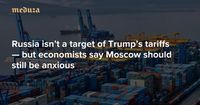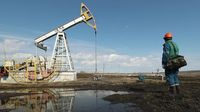On Wednesday, April 9, 2025, the United States escalated its ongoing trade tensions with a new round of "reciprocal" tariffs on imports from dozens of countries, significantly affecting Chinese goods, which now face duties of up to 104 percent. In retaliation, Beijing announced its own tariff hike on U.S. exports, raising them to 84 percent. This tit-for-tat exchange is not just a bilateral issue; the ramifications of this trade war are expected to ripple across the globe, especially impacting countries like Russia.
According to Natalia Milchakova, an analyst at Freedom Finance Global, China might pivot away from exporting certain goods and materials to the U.S. in favor of increasing shipments to BRICS countries, which include Brazil, Russia, India, China, and South Africa. This shift could alter the dynamics of international trade and commerce, particularly for nations that rely heavily on Chinese imports.
On April 8, 2025, Elvira Nabiullina, head of the Central Bank of Russia, expressed concerns regarding the potential escalation of the tariff war. She warned that such conflicts typically lead to a slowdown in global trade and could diminish demand for energy exports, which are crucial for Russia's economy. "If this tariff war escalates, it typically leads to a slowdown in global trade and the world economy — and possibly a drop in demand for our energy exports," Nabiullina stated, as reported by state media.
The immediate impact of these tariffs has already been felt in the oil market. Oil prices have plummeted sharply since April 2, 2025, dubbed "Liberation Day" by President Trump when he announced new tariffs on nearly 90 countries. This decline poses a significant threat to Russia's economy, which heavily relies on oil and gas revenues, accounting for about 25–30 percent of total income, as highlighted by the Finance Ministry's updated federal budget outlook.
In a worst-case scenario, analysts predict that Trump's trade war could halt global growth entirely. A leaked report from the Central Bank indicated that OPEC's spare capacity is now equal to Russia's current exports, suggesting that Russia may need to cut prices to remain competitive in the global market.
To rebuild its national rainy-day fund amidst falling oil prices, the breakeven oil price in Russia's budget would need to drop to $40 a barrel by 2027. This adjustment could lead to a GDP contraction of 3–4 percent in 2025, followed by an additional 1–2 percent decrease in 2026. Inflation is also expected to spike, potentially reaching 13–15 percent in the first year, with the Central Bank likely raising interest rates to an average of 22–25 percent in 2025.
Consumer demand in Russia could see a significant decline, with estimates suggesting a drop of 2.5–3.5 percent in 2025 and another 1.5–2.5 percent in 2026. This situation is particularly alarming when compared to previous years, where consumption fell by 1.1 percent in 2022, 6.5 percent in 2023, and an estimated 6 percent in 2024.
The trade war's impact extends beyond Russia's borders. In 2024, Russia imported approximately $115 billion worth of Chinese products, while the U.S. imported around $439 billion, a figure projected to decrease by 80 percent over the next two years, equating to a loss of about $350 billion. In contrast, the BRICS countries collectively import just over $200 billion worth of Chinese goods annually, a figure unlikely to increase significantly in the near future.
Economists have voiced skepticism regarding the BRICS countries' ability to replace the U.S. market for Chinese goods. Alexander Isakov, an economist at Bloomberg Economics, pointed out that while some Chinese exports might flow to Russia and other BRICS nations, the overall capacity of these markets remains insufficient. "Combined, the BRICS countries import just over $200 billion worth of Chinese goods annually — and that figure is likely to remain stable in the near future," Isakov stated.
Furthermore, Oleg Shibanov, another economist, emphasized that it is unrealistic to expect BRICS markets to absorb the volume of goods displaced by U.S. tariffs. He noted that Chinese exporters might revert to their 2018–2019 strategy of routing goods through third countries to access the U.S. market.
As the trade war intensifies, China's export strategies are evolving. Ilona Gorsheneva-Dolunts, a representative of the Russian business association Opora Rossiya in China's Guangdong province, confirmed that China is indeed redirecting its exports due to the tariff wars with the U.S. and the EU. She highlighted potential growth in Chinese exports to Russia across various sectors, including industrial equipment, cars, electronics, clothing, and green technologies.
Despite these shifts, Russia may not welcome an unchecked influx of cheap Chinese goods. As a member of the Eurasian Economic Union (EAEU), Russia has access to a range of trade defense tools, including anti-dumping measures, which can take several months to a year to implement. Medvedkov, an expert in trade policy, cautioned that Russia should prepare for an influx of goods from various countries, as nations excluded from U.S. deals will seek new markets.
In summary, the ongoing trade war between the U.S. and China has far-reaching implications for Russia, particularly concerning its oil revenue and economic stability. As the situation develops, stakeholders will need to navigate the complexities of shifting trade dynamics while preparing for potential economic challenges ahead.





